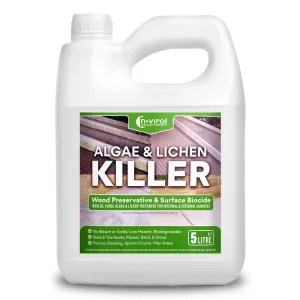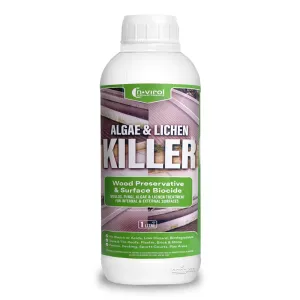This article digs into the science behind how these damaging organisms pose a risk to the integrity of outdoor hard surfaces, your safety - and what you can do about it.
The Difference Between Algae and Lichen
Algae and lichen can cause similar problems, but there are subtle differences. Algae produce a green film and are fast-growing at surface level. As well as providing a serious slip hazard, they can cause significant damage to asphalt shingles (as the algae feed on the limestone filler slowly weakening the shingle structure) and they can also stain porous surfaces.
Lichens form in crusty patches, are slower growing and can penetrate the surface of porous surfaces like stone, tiles, wood and concrete. They excrete oxalic acid and other compounds that can cause slow, chemical weathering and erosion over time.
The Hidden Slip Risk
After rainfall, green / grey algae and lichen organisms create a microscopic, water-saturated slime called mucilage. This biological layer reduces friction to zero, transforming your patios, pathways, or wooden decks into the equivalent of a frozen surface.

The slipperiness comes from the substance that holds this community together. It includes:
- Exopolysaccharides (EPS): This is the key culprit. Algae excrete this slimy, sticky, gel-like substance, which is composed mainly of complex carbohydrates (polysaccharides).
- A natural lubricant: These polysaccharides are highly hydrophilic (water-loving). When they get wet from rain, dew or moisture, they absorb a lot of water, turning the layer into a very effective, low-friction natural lubricant - like a thin layer of slippery gel over the hard surface.
When you step on this layer, the mucilage cannot provide enough friction for your shoe sole to grip the hard wood or stone underneath, causing your foot to slide right across the wet, slimy film.
Preventing Growth and Curing Algae and Lichen
Algae love water and shade. Fixing any drainage issues and pruning overhanging plants to reduce shade can help make the environment more inhospitable to their growth.
However, biocides (algae killers) are the only proven way to comprehensively kill algae and lichen for long-term prevention. Do not be tempted to use high pressure water when removing algae as this can damage surfaces and encourage faster regrowth by making the surface more porous.
How Biocides Like N-Virol Kill Algae
The secret to how N-Virol works lies in its main ingredient, Didecyldimethyl Ammonium Chloride (DDAC), which is essentially a powerful germ-killing soap. It works by chemically dissolving the outer layer of the algae, moss, and other microbes on contact as follows:
- The DDAC molecule is like a tiny magnet with a positive charge. The surface of the algae's skin has a negative charge, so the DDAC is strongly attracted to it.
- The DDAC molecules wedge themselves into the algae's cell membrane. This causes the membrane to fall apart and become full of holes. All the vital contents of the algae cell leak out instantly, which kills the cell quickly.
- The product also acts like a mild detergent (soap) to help break down the dead algae over the following weeks, keeping the surface cleaner for longer.

Why Outdoor Surfaces Are Prime Targets
Decking, patios, pavements, fences, and walls create the ideal environment for algae to grow its slippery biofilm. Outdoor surfaces, especially porous materials like concrete, stone, and wood, retain moisture for long periods, which algae needs to thrive. The surface stays wet long after the rain stops.
Areas under trees, near walls, or on the north side of a house receive less sunlight and less airflow, preventing the surfaces from drying out quickly. Algae flourishes in these perpetually damp, shaded conditions.
Organic debris like fallen leaves, dirt, and dust settle on the surface. When they decompose, they provide the necessary nutrients for the algae to grow rapidly.
Now you know how algae and lichen form, the risk they pose to safety, the long-term risk to the structure of outdoor surfaces, and how to prevent and get rid of them, you can look forward to cleaner, brighter, safer outdoor surfaces!
As always, please do get in touch with our technical team if you have any questions or concerns about algae growth.





